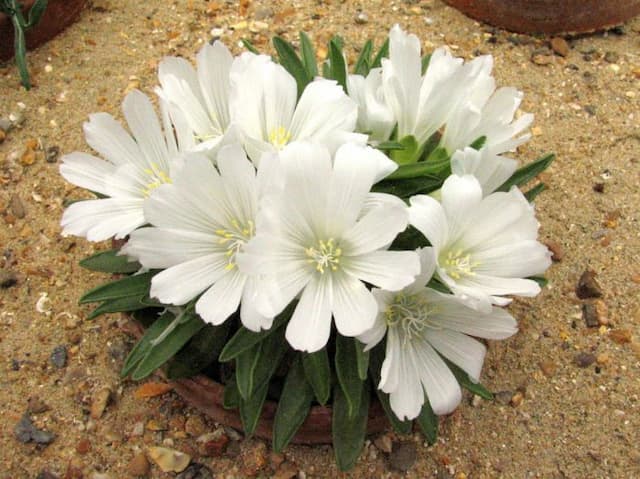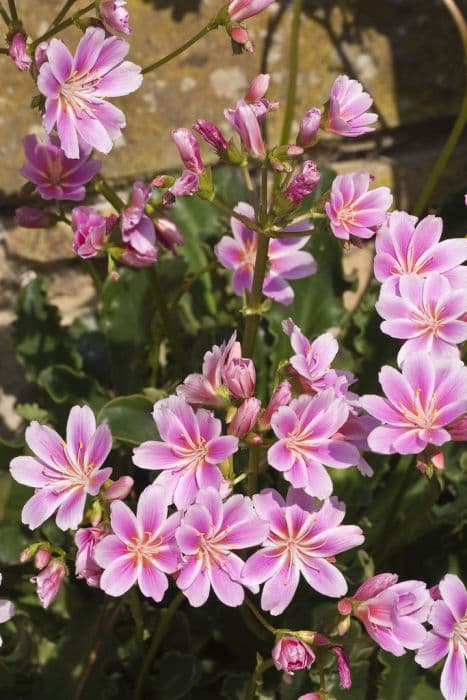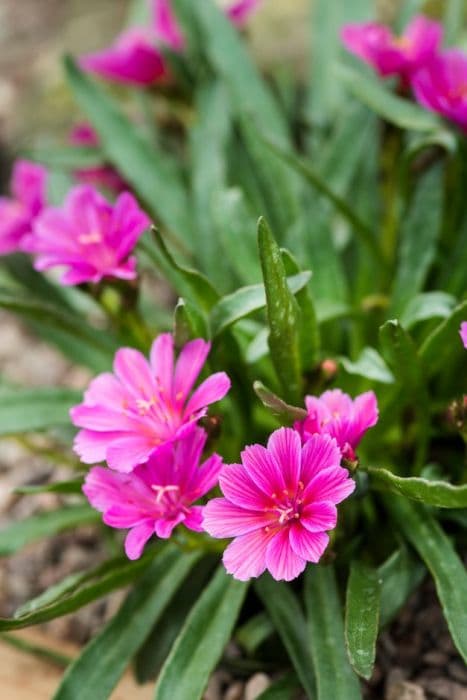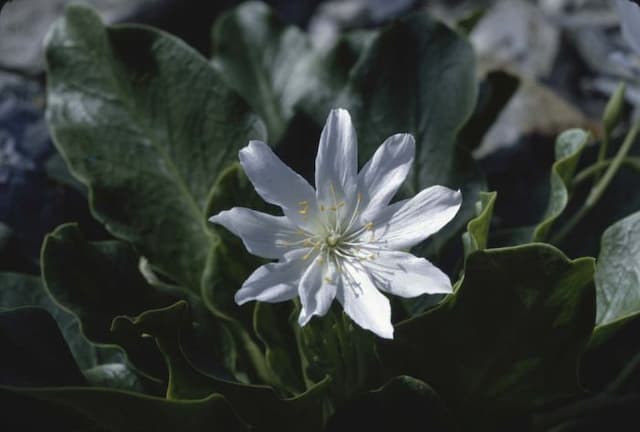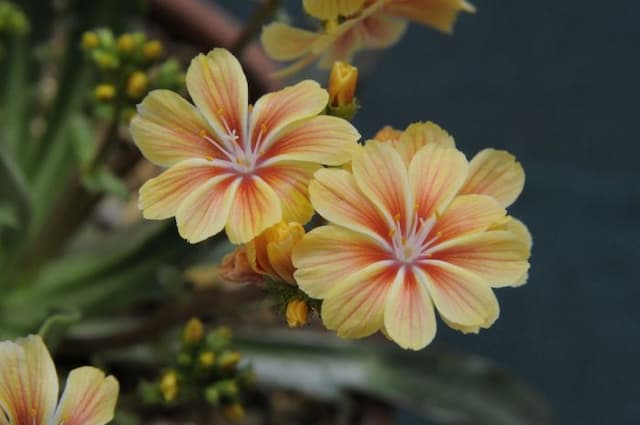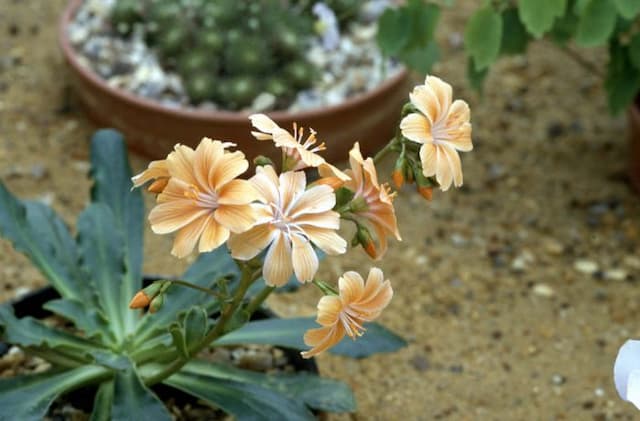Tweedy's Lewisia Lewisiopsis tweedyi

ABOUT
Lewisiopsis tweedyi, commonly known as Tweedy's lewisia, is a perennial plant that is particularly noted for its attractive flowers and foliage. The plant typically forms a rosette, a circular arrangement of leaves growing close to the ground. These leaves are fleshy, often described as succulent, with a spoon-shaped appearance, sporting a smooth to slightly serrated edge. They can present a lush green color and may sometimes exhibit a reddish tinge on the margins under certain growing conditions. The flowers of Tweedy's lewisia are its most striking feature. They appear on stout stems that rise from the rosette of leaves. Each flower is sizeable and showy with multiple petals arranged in a radial symmetry, resembling a small cup or bowl. The blooms come in an array of colors, including shades of pink, orange, yellow, and white, often with contrasting veins or centers that add to their ornamental appeal. The blossoms may also display subtle color gradients, blending from one hue to another toward the center, and are known for their ability to attract pollinators like bees and butterflies. The blooming period of Tweedy's lewisia generally occurs in late spring to early summer, which is when this plant reveals its full splendor through its abundant and colorful floral display. After flowering, the plant will produce seed capsules, although the visual interest at this stage is less compared to the peak blooming season. Throughout its lifecycle, Tweedy's lewisia provides an attractive element to rock gardens, alpine collections, and areas of the garden where the beauty of its flowers can be appreciated up close. The plant is valued for its rugged beauty and the hardiness that allows it to thrive in rocky, well-drained soils.
About this plant
 Names
NamesFamily
Montiaceae
Synonyms
Tweedy's Lewisia, Tweedy's Bitterroot
Common names
Lewisia tweedyi, Oreobroma tweedyi.
 Toxicity
ToxicityTo humans
Tweedy's lewisia, commonly known as Lewisiopsis tweedyi, is not widely known to be toxic to humans. There is limited information regarding its toxicity, as it is primarily grown for ornamental purposes. However, as with many plants, it is always advisable to exercise caution and not ingest any part of an unknown plant due to potential risks of adverse reactions.
To pets
Tweedy's lewisia, commonly known as Lewisiopsis tweedyi, is also not widely recognized as toxic to pets. However, as with any plant not typically part of a pet's diet, it is prudent to prevent your pets from ingesting this plant. If a pet does consume parts of the plant, monitoring for any signs of gastrointestinal upset or allergic reaction is advisable, and consulting a veterinarian if any concerning symptoms arise.
 Characteristics
CharacteristicsLife cycle
Perennials
Foliage type
Deciduous
Color of leaves
Green
Flower color
Yellow
Height
2 feet 8 inches (0.81 meters
Spread
2 feet (0.60 meters
Plant type
Herb
Hardiness zones
4
Native area
North America
Benefits
 General Benefits
General Benefits- Ornamental Value: Lewisiopsis tweedyi, commonly known as Tweedy's lewisia, adds aesthetic appeal to gardens with its striking flowers and attractive foliage.
- Drought Tolerance: This plant is highly drought-resistant, making it suitable for waterwise gardens and xeriscaping.
- Cold Hardy: It can withstand cooler temperatures, which allows it to thrive in a variety of climates.
- Low Maintenance: Tweedy's lewisia requires minimal care once it's established, making it ideal for gardeners looking for low-maintenance options.
- Attracts Pollinators: Its vibrant flowers attract bees, butterflies, and other pollinators, enhancing biodiversity.
- Soil Erosion Control: The root system of Tweedy's lewisia helps to stabilize soil and prevent erosion on slopes and banks.
- Long Blooming Period: This plant boasts a long flowering season, which can provide extended visual interest in the garden.
- Rock Gardens: Well-suited for rock gardens due to its alpine origins and preference for well-drained soils.
- Container Gardening: It's suitable for pots and containers due to its compact size, which is ideal for balconies and patios.
- Versatility in Landscaping: Tweedy's lewisia can be used in a variety of garden designs, from borders to mass plantings.
 Medical Properties
Medical PropertiesThis plant is not used for medical purposes.
 Air-purifying Qualities
Air-purifying QualitiesThis plant is not specifically known for air purifying qualities.
 Other Uses
Other Uses- Lewisiopsis tweedyi, commonly known as Tweedy's lewisia, can be used as a natural pest deterrent in gardens due to its thick, waxy leaves that are less appealing to common garden pests.
- The blooms of Tweedy's lewisia can be used in floral arrangements for their unusual and striking appearance, which adds a unique touch to bouquets and centerpieces.
- Tweedy's lewisia foliage can be used in ornamental crafts, such as in making evergreen wreaths or decorations for its texture and longevity.
- The plant can serve as a teaching tool for botany and horticulture lessons, owing to its specialized adaptations to rocky environments and unique water storage abilities.
- Tweedy's lewisia can be used in rock gardens to stabilize slopes and prevent soil erosion because of its ability to root firmly into crevices.
- The plant's distinctive colorful bloom can be a natural dye source for fabrics and papers, giving a distinctive hue that is extracted from its petals.
- Tweedy's lewisia can be an interesting subject for photographers and artists, who may capture its beauty for artistic inspiration or botanical illustration.
- This plant can play a role in xeriscaping, a landscaping technique that reduces or eliminates the need for irrigation, as it is drought tolerant once established.
- Tweedy's lewisia, with its alpine origins, can be used in educational displays to demonstrate the types of vegetation found in mountainous terrains and alpine biomes.
- The contrasting colors and textures of Tweedy's lewisia make it suitable for sensory gardens, designed to provide experiences for touch, sight, and smell.
Interesting Facts
 Feng Shui
Feng ShuiThe Tweedy's Lewisia is not used in Feng Shui practice.
 Zodiac Sign Compitability
Zodiac Sign CompitabilityThe Tweedy's Lewisia is not used in astrology practice.
 Plant Symbolism
Plant Symbolism- Rarity and Exclusivity: Lewisiopsis tweedyi, commonly known as Tweedy's Lewisia, is a rare and unique plant that symbolizes the special and the uncommon. It's not often found in the average garden, which adds to its allure and represents exclusivity.
- Resilience: Tweedy's Lewisia is known for its ability to survive in rocky, alpine environments. This hardiness makes it a symbol of overcoming adversity and thriving in challenging conditions.
- Beauty in Simplicity: With its delicate flowers and simple appearance, Tweedy's Lewisia symbolizes the beauty that can be found in simplicity and the idea that there's no need for ostentation to be truly beautiful.
- Adaptability: As Lewisiopsis tweedyi can adapt to various harsh environments, it becomes a symbol of adaptability and flexibility in life's circumstances.
 Water
WaterTweedy's lewisia requires consistent moisture, but it's important not to overwater, as this can lead to root rot. Water when the top inch of soil feels dry to the touch, providing about one inch of water per week. In hot or windy weather, you may need to water more frequently to ensure the soil stays moist but is not waterlogged. During the winter months, water less often, allowing the soil to dry out more between waterings. It's best to use a watering can or a hose with a gentle spray to water at the base of the plant, avoiding wetting the foliage.
 Light
LightTweedy's lewisia thrives in full sunlight to partial shade. The ideal location is a spot where the plant can receive at least six hours of sunlight per day. However, in particularly hot climates, some afternoon shade can prevent scorching of the leaves. Morning sunlight with partial afternoon shade is often an ideal balance for the healthiest growth.
 Temperature
TemperatureTweedy's lewisia prefers cool to moderate temperature conditions and is hardy in a range spanning from approximately 20°F to 75°F. However, ideally, they flourish in temperatures between 60°F and 70°F. They are not suited to extreme heat or prolonged freezing temperatures, and a drop below 20°F can be harmful.
 Pruning
PruningPrune Tweedy's lewisia to remove dead or diseased foliage, which can help prevent the spread of disease and improve air circulation. Deadheading spent blooms will encourage more flowering. Pruning is best done in early spring or just after the blooming period to allow new growth to emerge.
 Cleaning
CleaningAs needed
 Soil
SoilTweedy's lewisia prefers well-draining soil with a slightly acidic to neutral pH of 6.0 to 7.0. A recommended mix could be a blend of loam, sand, and fine pine bark or peat moss to ensure good drainage and air circulation.
 Repotting
RepottingTweedy's lewisia does not require frequent repotting and should be repotted every 2-3 years or when the potting mix breaks down or the plant outgrows its container, to prevent root crowding.
 Humidity & Misting
Humidity & MistingTweedy's lewisia thrives with moderate humidity levels but can tolerate some dry air; aim for a humidity level of around 40-50% for optimal growth.
 Suitable locations
Suitable locationsIndoor
Place in bright, indirect light, with cool temps.
Outdoor
Needs partial shade, protection from harsh sun.
Hardiness zone
4-8 USDA
 Life cycle
Life cycleLewisiopsis tweedyi, commonly known as Tweedy's lewisia or Tweedy's bitterroot, begins its life cycle as a seed, typically germinating in the cool, moist conditions of late winter or early spring. Once the seed sprouts, it develops a rosette of succulent leaves close to the ground as it enters the vegetative stage, gathering energy through photosynthesis. As warmer weather arrives, it progresses to the flowering stage, producing attractive flowers that range from white to pink, with each capable of attracting pollinators. After successful pollination, the plant sets seed, which then matures within a capsule that eventually dries and releases the seeds back into the environment. Throughout the summer or as conditions become drier, Lewisiopsis tweedyi may go dormant, ceasing aboveground growth and relying on its thick taproot to survive through adverse conditions until the next favorable growth period. This perennial plant repeats this cycle annually, living for several years and spreading gradually as its seeds are dispersed in the environment.
 Propogation
PropogationPropogation time
Spring-Early Summer
Propogation: Lewisiopsis tweedyi, more commonly known as Tweedy's lewisia or Tweedy's bitterroot, is best propagated through seed sowing. For successful germination, seeds should be sown in late fall to early winter, allowing them to experience a natural cold stratification process, which improves sprouting. Sow the seeds on a well-draining potting mix, lightly covering them with soil. The pot should be watered carefully to keep the soil moist, but not waterlogged, and placed in a bright, but not directly sunny, location. Germination can take several weeks, and it’s important to maintain consistent moisture and temperature during this period to ensure the seeds have the best chance at sprouting. Once seedlings are large enough to handle, they can be transplanted into their own pots or suitable locations in the garden.
